The heroes
Advice from the magazine "jeux et stratégie" Some spare parts Reparing games The Tasc Smartboard
- Are you looking for a user manual ? The way to find it on this page.
- Are you looking for some price quotation ? The Ebay price archive is on www.elpeon.com
- Are you looking for technical specifications ? Take a visit to the wiki Schachcomputer (in German)
- Do you have a question ? The chesscomputer forum
I had a small collection of electronic chess games. It was a rolling collection: I was selling my games to buy and try other ones. I only kept very few of these games.
1982-1992 is a period of great competition between the programs becoming stronger. It's a period for heroes: the developers who innovate and implement on small machines the best concepts coming from the university mainframes.
- Chess Traveller
- Graduate Chess
ADX Design
- Stratege
Applied Concepts Inc
- Boris
- Boris Diplomat
- Great Game Machine Sargon 2.5 & Morphy
- Morphy Encore
- Odin Encore
- Steinitz Edition 4
AVE Micro Systems
- Sargon 2.5 Auto Response Board
CXG / CGL / Schneider
- Alicante
- Chess 3000
- Chess Mate
- Chessmaster MK5
- Computachess II
- Computachess Travel Sensory
- Granada
- Madrid
- Portachess
- Sensor Computachess
- Seville
Conchess
- Ambassador
- Escorter
- Monarch
Excalibur
- Alexandra the Great
- Chess Station
- Electronic Backgammon
- Grandmaster
- King Arthur
- Mirage
- Phantom Force
- Portachess II
- Saber IV
- Touch Chess II
Fidelity Electronics
- Backgammon Challenger
- Bridge Challenger
- Bridge Challenger III
- Champion Sensory Challenger
- Checker Challenger
- Chess Challenger Voice
- Chess Challenger 3
- Chess Challenger 7
- Chess Challenger 9
- Chess Challenger 10
- Chesster Challenger
- Dame Challenger
- Designer 1500
- Designer 2000
- Designer display
- Eldorado
- Elite A/S
- Excellence
- Excel 68000
- Excel Display
- Excel Mach III
- Gambit
- Gin & Cribbage Challenger
- Marauder
- Micro Backgammon Challenger
- Micro Chess Challenger
- Mini Sensory Chess Challenger
- Par Excellence
- Reversi Sensory Challenger
- Sensory Chess Challenger 6
- Sensory Chess Challenger 8
- Super Nine
- Tiny Chess
- The classic CC8
- Ultimate Chess Challenge
- Voice Sensory Chess Challenger
Gakken, Lansay
- Computer Chess Game
Hegener & Glaser / Mephisto
- Mephisto
- Mephisto 2
- Mephisto Almeria
- Mephisto Berlin
- Mephisto Berlin Professional
- Mephisto Europa
- Mephisto Europa A
- Mephisto Europa A (Schachschule)
- Mephisto Genius 99
- Mephisto Junior
- Mephisto London
- Mephisto Lyon
- Mephisto Manhattan
- Mephisto Marco Polo
- Mephisto Milano
- Mephisto Mini
- Mephisto Mobil
- Mephisto Mobil LCD / MM-3000
- Mephisto Modena
- Mephisto Mondial II
- Mephisto Monte Carlo IV
- Mephisto Montreal 68000
- Mephisto MM I
- Mephisto MM II
- mephisto MM IV
- Mephisto MM IV / MM V turbo
- mephisto MM V
- Mephisto MM VI
- Mephisto Portorose 68020
- Mephisto Polgar
- Mephisto Risc II
- Mephisto Roma II
- Mephisto Vancouver
- My First Mephisto
- Schachcomputer 64
krypton
- Micro Chess
- Pioneer
Lansay
- Chess King Pocket Micro
Lexibook
- Chess Pro
- Chesslight
- ChessManLight
- ChessMan Pro
- LCD Computer Chess
- Travel Chess Explorer
Mattel
- Computer Chess
- Othello
Micro Games USA
- Backgammon 2
Millennium 2000 GmbH
- Chess & Games
- Karpov Schachpartner
- Orion 4 in 1
- Orion 6 in 1
- Orion Intelligent Chess
Milton Bradley
- Milton
Novag
- 2robot
- Agate
- Agate Plus
- Amber
- Amethyst
- Aquamarine Premier
- Beluga
- Chess Champion MK I
- Chess Champion MK II
- Chess Champion Super System III
- Chess Partner 2000
- Chess Printer
- Chinese Chess
- Citrine
- Condor
- Constellation 3.6 MHz
- Constellation Expert
- coral
- Diablo 68000
- Emerald Classic
- Escort
- Graphite (Pack Initation)
- Granite
- Jade
- Jasper
- Jasper Special
- Mentor 16
- Mentor Junior
- Micro Chess
- Micro II
- Obsidian
- Onyx
- Opal
- Opal II
- Piccolo
- Play with Mickey
- Presto
- Primo
- Ruby
- Sapphire
- Sapphire 2
- Secondo
- Solo
- Star Opal
- Star Sapphire
- Super Constellation
- Super Expert 6
- Super Expert B
- Super Expert C
- Super VIP
- Supremo
- Topaz
- Tourmaline
- Tourmaline Plus
- Turquoise
- Zircon
- Zircon II
Phoenix Chess System
- Resurrection II
Prinztronic
- Chess Traveller
Promedic Manufacturing Inc.
- Chess Master
Radiophon
- Chess Master
- Chess Master Diamond
RadioShack, Tandy, Go, Intertan
- 1450
- 1650
- 1650 fast response
- Super 1680L
- 1850
- 2 in 1 e-Chess and Checkers
- Chess Champion 2150
- Chess Champion 2150L
- Chess Champion 2250xl
- Compact Dames
- Computerized Chess Game
- Electronic Checkers
- Electronic Dames
- Master 2200x
Saitek
- 4 in 1
- Alchemist
- Aragon
- Atlas
- Blade
- Bravo
- Bridge Shadow
- Calculator Chess
- Capella
- Centurion
- Chess Companion
- Chess Companion III
- Chess Explorer
- Chess Partner 2
- Chess Shadow
- Coach Partner
- Compact Dames
- Conquistador
- Corona
- Dames Traveller
- Electronic Champion Backgammon
- Electronic Checkers
- Electronic Chess partner
- Electronic Chessman
- Electronic Dames
- Elite
- Explorer Pro
- Galileo Analyst C
- GK 2000
- GK 2100
- Handheld Champion Backgammon
- Junior Master Chess
- Kasparov Blitz
- Mephisto Chess Challenger
- Mephisto Chess Trainer
- Mephisto Maestro
- Mephisto Magellan
- Mephisto Master Chess
- Mephisto Senator
- Mephisto Solar Star
- Micro Travel Chess Computer
- MK 12 Trainer
- MK 14 Trainer
- Pocket Checkers
- Pocket Chess
- Pocket Plus
- President
- Pro Bridge 100
- Pro Bridge 200
- Schach-trainer
- Sensor Chess
- Sensor XL
- Sensory Backgammon
- Talking Chess Trainer
- Team Mate
- Travel Mate
- Turbo Advanced Trainer
- Virtuoso
SciSys
- Astral
- Concord II
- Chess Companion II
- Chess Intercontinental Traveler
- Chess Traveler
- Executive Chess
- Junior Chess
- Kasparov Plus
- Mini Chess
- MK 10
- MK 12
- Pocket Chess
- Pocket Plus
- Sensor Chess
- Rapier
- Superstar 28K
- Superstar 36K
- Turbo 16K
- Travel Mate
- Travel Sensor
Tiger
- Chess Grand Master
- Chess Marathon
- Electronic Galactic Chess
- Voice Master
Tsukuda
- Electronic Computer Othello
- Othello M-II
V-Tech
- Backgammon Master
Yeno
- 301 XL
- 320 XT
- 325 XL
- 416 XL
- 532 XL
- 540 XT
- Travel Chess
Milton (Milton Bradley)

 David Levy is an international chess master. He wrote several books and articles.
His company named "intelligent games" published several chess software between 1980 and 1986. The Milton
was developped by this company,probably by Mark Taylor.
David Levy is an international chess master. He wrote several books and articles.
His company named "intelligent games" published several chess software between 1980 and 1986. The Milton
was developped by this company,probably by Mark Taylor.This game was available under different names: "Grandmaster" in the USA, "Phantom" in England and "Milton" in Germany and in France. This game is the French one: see the text under the buttons.
The Milton was a revolution in 1983. It's a robot moving alone its pieces, with a magnetized arm moving under the chessboard. It's a very high quality hardware and it works fine today.
Here is a test game. It's weak in the openings, not to bad in the middle game and poor in the end.
Some links:
- An interview from David Levy.
- The MB history by Mike Watters .
Sensory Chess Challenger 9 (Fidelity)
 This is an historical game ! When it was published, in 1982, the Jeux et Stratégie magazine wrote :
It is better than any other chess computer available today except the Elite. It seems to be a slower release of the
Elite program. A real player, and a good one !
This is an historical game ! When it was published, in 1982, the Jeux et Stratégie magazine wrote :
It is better than any other chess computer available today except the Elite. It seems to be a slower release of the
Elite program. A real player, and a good one !It's a 16K program, running on a 6502 / 1,6 MHz, with an opening library of 3000 half moves. As an option, two modules were available to increase the opening library: the CB9 and the CB16. This program, written by Kathe et Dan Spracklen will be later enhanced, especially in speed and finales, but historically, the CC9 is the first release of one of the best programs ever written in the 80s: the Excel Mach III.
It's an interseting programme but it still has some weaknesses visible in this test game level 4 and this test game level 5. It's funny to compare the level 4 game with the one of mephisto 3 (very similar) and the one of the Novag Ruby (harder to beaty)
Elite A/S French (Fidelity)
 The Elite A/S (1983) is a nice wooden game derived from the CC9. This game speaks French. But the board is
a bit uncoloured..
The Elite A/S (1983) is a nice wooden game derived from the CC9. This game speaks French. But the board is
a bit uncoloured..There was different release of the Elite A/S, described on www.blitzchess.fr. This one is the first one, that displays the position evaluation in hexadecimal mode.
It's a nice software but with experience, it's easy to beat it, see this test game.
 Super Nine French (Fidelity)
Super Nine French (Fidelity)The Super Nine is derived from the Elite A/S (1983). They have a common user manual. This game speaks French. The software was very strong at that time but it was expensive and the design was a bit ugly. So this game was not a commercial success.
Here is a test game.
Excellence (Fidelity)

The Chess Challenger 9 was replaced in 1985 by the Excellence (in 3 and 4MHz) then by the Par Excellence (5 MHz) and the Excel series.
Compared to the CC9, the progress are significant in every game aspects but it is still missing speed. Here is a nice test game. So it's evaluated around 1650-1700 ELO. The flat box design is not so nice, with only two rows of leds, and later the Excel series will come back to the CC9 look.
 Fidelity Designer 2000
Fidelity Designer 2000The designer 2000 (1987) contains the Fidelity Excellence program (1985) in a chess board designed by the Italian artist Franco Rocco. The 2000 number indicates a US estimation of the Elo level.
At the same time, the Designer 1500 included the weak Chess Challenger 8 program and the Designer 2100 the very good "Par Excellence". In 1990 / 1991, the Excel Mach III and IV were also proposed as "Designer 2265 master" and "Designer 2325 master".

 In 1986, Jeux et Stratégie introduced the Par Excellence:
A lot stronger than the Excellence. 32K program better as the Elite Avant Garde for a low cost. 5MHz clock. Opening library
of 6000 moves. The absolute weapon in the chess computers !.
In 1986, Jeux et Stratégie introduced the Par Excellence:
A lot stronger than the Excellence. 32K program better as the Elite Avant Garde for a low cost. 5MHz clock. Opening library
of 6000 moves. The absolute weapon in the chess computers !.It played an agressive and efficient game. But with experience, it's possible to find a strategy to beat him: For instance in my test game, the Par Excellence did not open early enough a closed game in the centre and did not answer properly to a h pawn attack to break the castling defense.
The two following models were the Excel 68000 (12 MHz) and the Mach II (12 MHz). But they both had software quality problems and were only a bit better than the Par Excellence. Only the Mach III (16 MHz) and the Mach IV (68020 ŕ 20MHz, around 2000 Elo) significantly increased the game level.
Fidelity Designer 2100 / Designer Display
 The designer display is a very good game derived from the "par excellence". This
"display" model includes a little LCD screen.
Here is a test game
The designer display is a very good game derived from the "par excellence". This
"display" model includes a little LCD screen.
Here is a test gameIt looks nice but the grey pieces are losing their color.

 Fidelity Chesster Challenger
Fidelity Chesster ChallengerThe Fidelity Chesster Challenger is a Fidelity Par Excellence variant. The major difference is a large use of a voice synthetizer. The game is making a lot of comments in English, including some to help beginners. It has a real sense of humour.
After having switch on the game, you can push the h1 square to listen to all the Chesster vocabulary and it will take around 10 minutes !
Here is a test game. The last comment of the Chesster was "you won but you took back moves". And of course it was right.
Excel Display (Fidelity)

The Excel Display is packaged like the very good Excel 16 bits serie. But it just includes the Excellence hardware and software with a LED display added. The small difference: there are only 15 leds on th chessboard against 64 for the Excel 16 bits serie.
The owner's manual is common to the "Excellence" (model 6080), "Excellence Voice" (6093) and "Excel display" (6092). The metallic looking pieces are losing their colour when used (here: b1 c1 b2 f2 h2).
It is still a very interesting software, see this nice test game, but it can not compete to the world championship.
 Excel 68000 (Fidelity)
Excel 68000 (Fidelity)The Excel 68000 was the first Excel 16 bits. It's a very strong player, designed for the world championships. It's also the first chess computer using hash tables to improve the finales. A hash table keeps the different positions evaluated and cut the search tree on the positions already analyzed. The hash table is a bit small (16Ko) and there are still some programming mistakes, so the game has only a level of around 1850 ELO.
To beat it, I used a small trick I found with the Excel Mach III: the bishop attack.
Excel Mach III (Fidelity)

There are only few design differences between the Excel Display and the Excel Mach III: the "Chess Challenger" and "Fidelity Electronics" texts are in gold instead of silver and there are 64 leds on the chessboard. But the inside has nothing in common. The Mach III includes the chef d'oeuvre of Kathe and Dan Spracklen with a game level of 2000 ELO. The Jeux et Stratégie magazine described it well: a tiger in a soap box.
By luck, i found a bug helping me to beat it in this test game but it's a very strong player, very different from the other chess software. I tested it a lot during the summer 2007 and I lost a lot. But I had 3 victories: round 2, round 3 et round 4.
Mephisto I Brikett (Hegener & Glaser)

When the first Mephisto "briquette" appeared in 1981, Jeux et Stratégie wrote: This little black devil is one of the best machine available today. It can find mate in 4. An excellent price for the value.
Here is a test game.
Mephisto II (Hegener & Glaser)
 The Mephisto I was followed, in 1982, by this Mephisto II. One specificity of this program was its
human style. On this subject, you can read 2 articles in the
Computer Chess Digest 1983 magazine - page 5 : "Humans / Machines comparison test" and page 24 :
" The Mephisto Concept. A Humanlike thinking Chess Program" - written by Thomas Nitsche himself.
I found the mephisto II a bit weaker than the Mephisto I.
See this test game.
The Mephisto I was followed, in 1982, by this Mephisto II. One specificity of this program was its
human style. On this subject, you can read 2 articles in the
Computer Chess Digest 1983 magazine - page 5 : "Humans / Machines comparison test" and page 24 :
" The Mephisto Concept. A Humanlike thinking Chess Program" - written by Thomas Nitsche himself.
I found the mephisto II a bit weaker than the Mephisto I.
See this test game.This game for sale is in fact the Mephisto I above with 2 modules: the module I out of order (it hangs after 20/30 mn of use) and the Mephisto II module that works well.
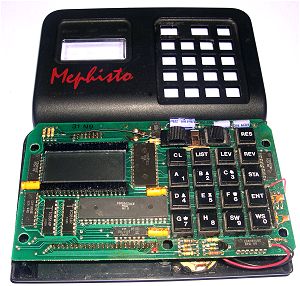 About the Mephisto 2S (a bit faster), Jeux et Strategie wrote: "Level similar to the Sensory 9. Not so good tactically
but better position principles and a good opening library that seems to be build to win against the Sensory 9". Richard,
who had both, compared them in a test game but CC9 won. The Mephisto
III did not make enough progress and H&G hired the English programmer Richard Lang for the Mephisto Amsterdam that became
World champion.
About the Mephisto 2S (a bit faster), Jeux et Strategie wrote: "Level similar to the Sensory 9. Not so good tactically
but better position principles and a good opening library that seems to be build to win against the Sensory 9". Richard,
who had both, compared them in a test game but CC9 won. The Mephisto
III did not make enough progress and H&G hired the English programmer Richard Lang for the Mephisto Amsterdam that became
World champion. The briquette was entered in the legend, and its name "Mephisto" is still today a reference.
 Mephisto Junior
Mephisto Junior Mephisto Mobil
Mephisto Mobil LCD / MM-3000
Three variants of the Mephisto Briquette:
- Mephisto Junior (1982) is a variant of Mephisto I (weak program - test game)

- Mephisto Mobil (1985) contains the Mephisto Mirage module (A faster Mephisto II). A test game (where I did not play well).
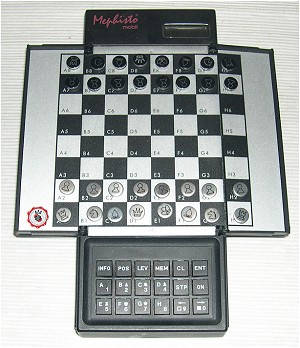
- The second Mephisto Mobil has its own LCD screen on the top right. The magnet pieces are not the original one. It contains the MM3000 module, a variant of the Mephisto III. The MM-3000 name is indicated on asticker on the back of the module. But I mainly used it with the MM-V which is compatible.
Mephisto 3 was a good software but it's possible to beat him in less than 20 moves. This is my most preferred game , it's the basis of all my tests.
.
Mephisto module MM-I or MM-3000 ?

This is the first module build for the Mephisto Exclusive / Modular chessboards. In reality, it has no name. Nothing is indicated on the module and the user manual only indicates: "Modular / Exclusive".
This is a software very similar to the Mephisto III and probably identical to the MM-3000 sold inside the mephisto Mobil LCD. A small difference: The Mephisto III is based on a 1802 processor at 6,1 MHz, the MM-I is based on a 1806 at 8 MHz.
It's not easy to understand all the variants of the mephisto 3 project: There was 2 releases of the Mephisto 3. There was also a module III-S for the Glasgow world championship. And before the mephisto exclusive, there was 2 auto response boards that may be connected to a Mephisto III: the ESB 3000 and ESB 6000.
It's an interesting software but it is quite easy to beat it. So it's more for player starting in a club, see this test game.
Conchess Ambassador
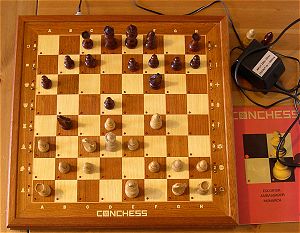 Ulf Rathsman was discovered with the Conchess Ambassador. The Conchess program was 2nd in
the 1981 world championship after the Elite. This auto-response board Conchess Ambassador was sold around 3000F end 1982.
The program has a similar level as the Chess Challenger 9. See this test game. In 1984, an
opening module was available that clearly improve the game level. the program was also available in a plastic design (Escorter, 2400F)
and as wooden marquetry design 53cmx53cm (Monarch, 4000F).
Ulf Rathsman was discovered with the Conchess Ambassador. The Conchess program was 2nd in
the 1981 world championship after the Elite. This auto-response board Conchess Ambassador was sold around 3000F end 1982.
The program has a similar level as the Chess Challenger 9. See this test game. In 1984, an
opening module was available that clearly improve the game level. the program was also available in a plastic design (Escorter, 2400F)
and as wooden marquetry design 53cmx53cm (Monarch, 4000F).Conchess Monarch
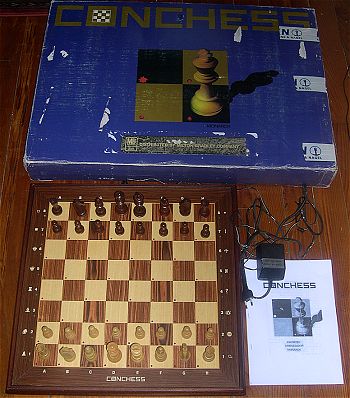
The Conchess Monarch is a turnament size game, bigger than a Mephisto Exclusive.
This game includes the base module called "Conchess". Other modules were produced but they are very rare. More information on these modules is available on: www.chesscomputeruk.com.
The Conchess games are fragile and you often have to change some magnetic sensors "Reed / ILS" or clean the contactors. Hopefully, the electronic board is very simple and it is quite easy with the help of the 2 following sites: http://www.ismenio.com ou http://www.chesscomputeruk.com
Here is a test game at 2 moves depth - 5mn per move and a test game in turnier mode / 2mn per move.
 Conchess Escorter
Conchess EscorterThe Conchess Escorter is a game smaller than the Ambassador. It has a nice modern design, in metallic coloured plastic. It's nice to be used because it's an auto-sensory game: There is no need to push the squares during moves.
Here is a test game..
 Mephisto Exclusive MM-II
Mephisto Exclusive MM-IIThe mephisto MM-II has nothing in common with the Mephisto 2. The MM-II is a software from Ulf Rathsmann, published in 1985 by H&G, at the same time as the Mephisto 16 bits from Richard Lang, and the Mephisto Mondial from Frans Morsch. This exclusive chessboard works well, but the user guide is a copy - in English only.
From Jeux et Stratégie, it's tactically very strong, very good to solve problems, very good in blitz but strategically very weak. Here is a test game. It is rated 1800 ELO, not so bad !
Yeno 532 XL (1989)

Yeno was a French company specialized in electronic games. The 532 XL was the first computer chess produced by Yeno.
It contains a very good program from Ulf Rathsman, with an estimated rating of 1850 ELO and probably very similar to the Mephisto MM-II. It's a program of 32K running on a 65c02 / 4MHz with an opening library of 3000 positions and a very competitive price (1200 F). It's still today an impressive player, including mid and end games. A test game
This game has a damaged box.
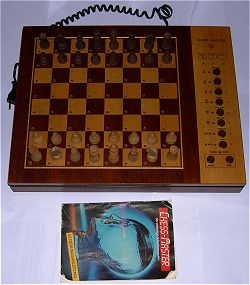 Chess Master (Radiophon)
Chess Master (Radiophon)The Chess Master was produced in East Germany (DDR) in the mid 80s. It was distributed with a long instruction manual of 51 pages in German. It was an auto-response board looking robust. It used a u880d processor: a z80 clone produced in the communist Europe. The software is weak on fast levels but it is becoming a lot better on the best levels. Here is a test game level 3 . At his level (1 mn 30 per move), it still makes major mistakes. Here is a test game level 4 . it plays better (3 mn 45 par coup) with an interesting game style. There is also al level 5 with 8 mn per move.
Scisys Chess Companion II

The Chess Companion II was introduced in Jeux et Stratégie n°23 (1983): "Correct for the price". It was sold 990F (150 euros, $200). It contains the famous 4Kb software written by Kaare Danielsen on a 3,6 MHz processor. From the resume for Kaare Danielsen, variants of this programme were produced inside 200000 units. It is still used today by Lexibook (see the wiki schachcomputer.info).
The Chess Companion II is rated around 1400 ELO, see this test game .
 Scisys Concord II
Scisys Concord IIThe Concord II was published in 1985 and was an accelerated 7.2 MHz release of the 4Kb software from Kaare Danielsen. The same year, Scisys published the Turbostar from Julio Kaplan, a lot stronger and more expensive.
There has been perhaps a Scisys Concord (without II), 2 times slower, but it would be a very rare item. On the Concord II is written "Concord" and on the back label is written article N° 252. This is a weak software with a very agressive style; see this test game.
Tandy 1650 Fast Response Program
 The Tandy 1650 Fast Response Program is a variant of the Saitek Concord II. There are two other kind of Tandy 1650 visible
on Overtom' site.
The Tandy 1650 Fast Response Program is a variant of the Saitek Concord II. There are two other kind of Tandy 1650 visible
on Overtom' site.I opened the games to compare the hardware. There are some minor variants. The Tandy game from the picture has a motherboard REV D. So it is older than the Concord II that has a motherboard REV E. But there is also a younger Tandy 1650, with a motherboard REV H. This second Tandy 1650 has a minor packaging difference: the logo endorsed by The World Chess Federation was replaced by endorsed by Garry Kasparov - The world Champion. I compared the REV D and the REV H. The opening phase is very different but later, the game is very similar.
Here is the REV D test game. Its uncommon opening gave me many some difficulties. But I also played a first game much easier.
 Superstar 28K (SciSys)
Superstar 28K (SciSys)The Scisys Superstar was in 1984 one of the first programs of the junior world champion Julio Kaplan. It was then followed by the Superstar 28K and the Superstar 36K (1985). It's possible to upgrade the software module by opening the blue cover.
The software is quite good but it makes sometime errors. Here is a test game.
A link:
- An interview of Julio Kaplan about the Turbostar 432: There was a quantum leap between the previous SciSys Superstar machine and the current Turbostar, Kaplan contends.
 Superstar 36K (SciSys)
Superstar 36K (SciSys)The Scisys Superstar Superstar 36K (1985) is an imporved release of the Superstar 28K. The processor is a weak 6502 / 2MHz. But the 32K (+4K RAM) programme is focused on good positions and it is already a strong opponent. See this test game.
A link:
- A very nice game between Gary Kasparov and the Superstar 36K.
 Turbo 16K (SciSys)
Turbo 16K (SciSys)The Scisys Turbo 16K is from 1985. It's a 16Kb software on a 6301Y processor at 12MHz. It was the middle range game from Scisys. It plays with a nice style but is quite weak - around 1450 ELO. Here is a test game.
This game is partially out of order. Everything works fine except the 2 clock displays.
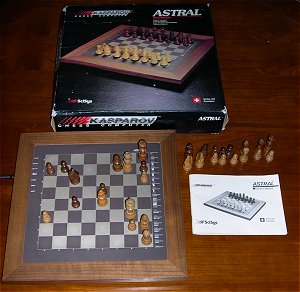 Astral (SciSys)
Astral (SciSys)The Scisys Astral is identical to the Turbo 16K. But it's a nice game in wood. From far away, it looks like the Saitek Corona but it is smaller and it's not an auto-response board : you have to push the squares to indicate the moves.
Here is a test game - it defends well but it miss agressivity as attacker.
 MK12 (SciSys)
MK12 (SciSys)The Scisys MK 12 is from 1986. It was a mass market device on a limited hardware: a 0,6 MHz processor (!).
In 1987, you could read in Jeux et Stratégie n°48 "to much weak for the price". But despite these comments, it was a commercial success. It later became black and white and was handovered by Scisys.
There are only 8 game levels (including an unlimited one), the take back function only works for 2 half moves, it's not possible to enter a position but it includes 8 studying positions. See this test game.
 MK12 Trainer (Saitek)
MK12 Trainer (Saitek)The Saitek MK 12 Trainer is from 1990. it looks like the Scisys except its black and white colour. The text on the top of the chessboard is identical: Chess Coash Opponent MK12. The "MK12 trainer" reference is indicated on a label on the rear side.
The software is a bit better: the processor speed is now 1MHz; There are 16 game levels including 7 for beginners (fun levels), a take back function on 6 half moves ans still 8 studying positions. The box also includes a booklet in English: Easy Steps to Winning Chess. Here is a test game.
 Super 1680L (Tandy)
Super 1680L (Tandy)The Tandy Super 1680L is from 1991. It looks like a 90° turned MK12. The software is probably a vriant of the Saitek MK12 trainer. It also has 16 game levels including 7 for beginners but there are no studying positions.
The game level is quite weak as visible in this test game.
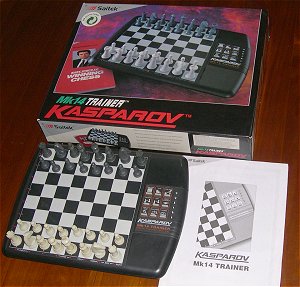 MK14 Trainer (Saitek)
MK14 Trainer (Saitek)The Saitek MK 14 Trainer is from 1994. It's a variant of the MK 12 trainer. The software is using a processor at 1MHz, a ROM memory of 7740 bytes and a RAM of 176 bytes. It's a game for beginers, with fun levels and 8 position to study.
The game was sold with a initiation book - not available here. Here is a test game.

Chess Shadow (Saitek)
The Chess Shadow is from 1990. It's a variant of the MK 12 trainer, on a 2 MHz processor.
The pieces symbols on the LCD screen are simplistic. The main required functions are available: take back on 6 half moves, beep sound at each move, display constrast tuning, game saved in memory when the game is switched off.
The software is weak. Here is a test game.
 Chess Companion III (Saitek)
Chess Companion III (Saitek)The Saitek Chess Companion III is from 1986. It also existed under the brand name Scisys. At that time, it was the middle price device with a 8MHz processor and a 16K software. It also existed as travel game under the name express 16K and then was accelerated to 12 Mhz under the names Turbo 16K and Astral. The package and the name look like the Scisys Chess Companion II but the hardware and the software from Kaare Danielsen was very different. Here is a test game.
 Tandy 1850
Tandy 1850The Tandy 1850 is from 1987. It's a clone of the Saitek Chess Companion III with a grey design. It also existed as travel game under the name Saitek Express 16K. It was later accelerated under the names Turbo 16K, Astral et Turbo 24K.
Jeux et Stratégie wrote in 1987: a success, a nice device that plays properly. Here is a test game.
Team Mate (Saitek)
 The "Team Mate" was the middle class device proposed by Saitek end 1988.
It was later sold under the name
Team Mate Advanced Trainer. It contains a
16K program from Julio Kaplan on a 6301 / 8MHz processor, with an opening library of 5000 half moves.
The same program was distributed on a travel chess board (Cavalier , Portable Advanced Trainer) and with a faster processor
(12 MHz) on the Conquistador and Astral models. It's a Chess Computer designed for young players who want to progress. It
plays a lot of variants so a young player can progress without being dismotivated.
The game is sold with an interesting book based on 8 grand master games with comments
and 64 key positions where you have to find the next move.
The processor is a bit slow and it clearly plays a better game at around 15 mn / move.
A test game showing its general level. and
a lost game against the Fidelity Excellence.
The "Team Mate" was the middle class device proposed by Saitek end 1988.
It was later sold under the name
Team Mate Advanced Trainer. It contains a
16K program from Julio Kaplan on a 6301 / 8MHz processor, with an opening library of 5000 half moves.
The same program was distributed on a travel chess board (Cavalier , Portable Advanced Trainer) and with a faster processor
(12 MHz) on the Conquistador and Astral models. It's a Chess Computer designed for young players who want to progress. It
plays a lot of variants so a young player can progress without being dismotivated.
The game is sold with an interesting book based on 8 grand master games with comments
and 64 key positions where you have to find the next move.
The processor is a bit slow and it clearly plays a better game at around 15 mn / move.
A test game showing its general level. and
a lost game against the Fidelity Excellence.
 Conquistador (Saitek)
Conquistador (Saitek)The Conquistador is a Team Mate with a faster processor (12MHz) and a double display used mainly as chess clock .
It's a very interesting player. Here is a test game. He is exchanging a lot of material.
Yeno 416 XL "Partner and Tutor"

The "Yeno 416 XL" was packaged for players who wants to learn. In theory, it contains a 250 pages book with 320 exercises on 40 different games visible on this picture. But in this game for sale, the book is missing and the user manual is a copy.
This game was produced in 1989 and it seems to be the successor of the "Team Mate Advanced Trainer": there are similarities in the packaging, It's also a 16K ROM program on a "HD 6301 Y" / 8 MHz processor. The Ram is 256 bytes. The opening library contains 2000 moves. It's still today a good computer to learn chess.Here are a funny game with a chaotic opening and 2 variants of my usual test game.
 Chess Champion 2150 (Tandy)
Chess Champion 2150 (Tandy)The Chess Champion 2150 is probably the last software realized by Julio Kaplan. It's a machine dérived from the Saitek Simultano. Its external design is similar to the Chess Champion 2150L one but it includes a different hardware and software.
The software is presented as rated 2150 ELO but in reality, it is 1750 ELO, and that's already not so bad.
Here is a test game.
Corona (Saitek)
 The Saitek Corona is probably the most mature software of Julio Kaplan. it's also a pretty machine, very nice
to use. it was published in 1988.
It's a real sensitive chessboard: no need to push the squares, the movements are detected by Magnetic sensors.
The Saitek Strategy was at that time to develop programs based on good positions. The developments were conducted by the
Junior World Champion 1967 Julio Kaplan.In the Saitek Catalogue, there was: "more agressives openings and a better position science".
The device can also store around 100 games (3400 half moves). They can be replayed. It's also possible
to search for games using a position. This memory can also be used for its own opening library.
The Saitek Corona is probably the most mature software of Julio Kaplan. it's also a pretty machine, very nice
to use. it was published in 1988.
It's a real sensitive chessboard: no need to push the squares, the movements are detected by Magnetic sensors.
The Saitek Strategy was at that time to develop programs based on good positions. The developments were conducted by the
Junior World Champion 1967 Julio Kaplan.In the Saitek Catalogue, there was: "more agressives openings and a better position science".
The device can also store around 100 games (3400 half moves). They can be replayed. It's also possible
to search for games using a position. This memory can also be used for its own opening library.It's a strong program of 64KO running on a 65c02 5MHz, probably very similar to the Saitek Simulatno, with a huge opening library of 100000 half moves. In the Saitek Catalogue was written "more agressive openings and a better psotion science." However, I found a weakness in the algorithm as you can see this test game.. But do not underestimate the strength of this game as you can see in this almost similar test game. where I really had grat problems.
My game has the wooden frame a little bit damaged on the top left. However, it is one of my TOP-5 preferred computer chess. It has a very nice game style in the mid game developments.
Galileo analyst C (Saitek)

End 1986, Scisys published this very nice wooden board under the name Leonardo with a 6301Y 12 MHz processor, 24K ROM & 8.25 K RAM. Nothing to do with Leonardo da Vinci, it was a tribute to a 16th Century player Leonardo Di Bona. In 1988, the same chessboard was renamed Galileo. The main hardware was a bit improved: It was still a 6301Y at 12Mhz but with 32K ROM & 8.25 Ko RAM.
The game was very nice but it only had 2 series of led (horizontal and vertical) and no screen. In 1989, the Galileo was replaced by the Renaissance, with one led per square and a lcd display.
The Leonardo Galileo and Renaissance are modular games and this Galileo includes the module Analyst C 8 MHz (that also adds a lcd display). The module includes its own processor and software. It is installed on the side and complete the main software without replacing it: some levels are using the main hardware; some other are using the module. The basic Leonardo and Galileo included an average software, rated 1550 ELO. The Analyst module serie (A B C D) was using a 6502 processor (4 6 8 and 10 MHz). The game level was improved to around 1750 ELO, with a very nice game style. Later, this chessboard also included 2 other very strong modules: The Saitek Sparc (2225 ELO, developed by Dan & Kathe Spracklen) and Brute Force (2018 ELO, developed by Frans Morsch).
Here are a test game with the basic Galileo and one with the Analyst C module.
Savant (Novag)

In the Jeux et Stratégie N° 8 and 12 (1981), you can read: High technology: unusual sensor LCD screen: you just have to touch the starting and the ending square on the screen. The opening library is big and well made. It can solve the mate in 7. Some weaknesses in finales.
However, this high technology was not reliable and this LCD screen had a short life expectency. So all the Novag Savant are now out of order.
 Constellation 3.6 MHz (Novag)
Constellation 3.6 MHz (Novag)In Jeux et Strategie N° 29 (oct 1984), it was written: the Constellation 3.6 offers the best value for the money with its price of 2250F. Especially, it's very efficient in mid game combinations. In our tests, the Constellation 3.6 is the best on 6 problems / 9 . Impressing. My personnal opinion is more moderate: in this test game, it is missing agressivity.
It was not a beautiful machine but it was a good marketing concept. Novag had understood the market need for very strong machines with an optimized price.
 Super Constellation (Novag)
Super Constellation (Novag)The Super Constellation is from 1984. At that time, it was simply the best software in the world in a modest look. It was also well known for its human game style. It is rated around 1750 ELO.
This game is a bit damaged: the Super Constellation text is erased on the metal bar.
Here is a test game.
 PRIMO (Novag)
PRIMO (Novag)In Jeux et Stratégie N° 48 (dec 1987), there was an article about the chess computers between 300 and 2000F (45 - 300 euros), with the following comments on the le Novag VIP: "Probably the most interesting of all the games tested. This pretty "calculette" with 24 keys plays well and include a lot of functions. Opening library of 2000 moves, 48 game levels. 1300F. very good price for such quality." The Novag Primo includes the same software inside a table chess board.
Here is a test game.
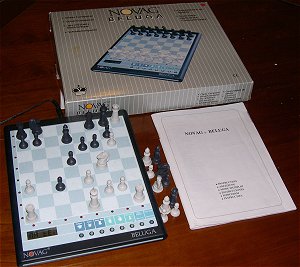 BELUGA (Novag)
BELUGA (Novag)The Beluga includes the same software as the Novag Primo with a more modern design. It's one of the first release of the classic 16Kb software.
This software is rated 1700 ELO but with experience, I beat it without difficulties in this test game.
SUPER VIP (Novag)
 The Super VIP is from 1989 and it includes minor enhancements compared to the VIP/Primo.
Novag distributed in this calculator package the best programs from David Kittinger: the VIP (8 bits processor,
8MHz, 16K, 1600 Elo), the super VIP (8 bit processor, 9,8 MHz, 48K, 1700 Elo),
the Ruby (Risc processor, 20MHz, 32K, 1900 ELO), the Sapphire (Risc processor, 26,6 MHz, 64K ROM, 2090 ELO) and the Sapphire II
(Risc processor, 32MHz, 160K ROM, 118K hashtables, 2100 ELO).
The Super VIP is from 1989 and it includes minor enhancements compared to the VIP/Primo.
Novag distributed in this calculator package the best programs from David Kittinger: the VIP (8 bits processor,
8MHz, 16K, 1600 Elo), the super VIP (8 bit processor, 9,8 MHz, 48K, 1700 Elo),
the Ruby (Risc processor, 20MHz, 32K, 1900 ELO), the Sapphire (Risc processor, 26,6 MHz, 64K ROM, 2090 ELO) and the Sapphire II
(Risc processor, 32MHz, 160K ROM, 118K hashtables, 2100 ELO).In fact and as you can see in this test game, the game level is far behind the Novag Ruby's one. But the Super VIP was compatible with the wooden Novag Universal Electronic Chess board. This possibility was removed for the Ruby (but existed again on the Sapphire and the Sapphire 2).
 Supremo (Novag)
Supremo (Novag)The Novag Supremo was published in 1988. It was available for 1750F (260 euros) and Jeux et Stratégie wrote: "A good success for a correct price. Program derived from the Super Constellation with less opening and finales algorithms. One of the best value for the money in the market".
The software used 32K ROM and 2K RAM on a 6301Y processor at 8MHz. The opening library includes more than 15000 half-moves. The cable on the picture is an adapter for the Novag printer. Here is a test game..
 Mentor 16 (Novag)
Mentor 16 (Novag)The Novag Mentor 16 was published in 1989. It's an evolution of the Novag Supremo, that was published in 1988 and had only one LCD screen. It contains a 16K program on a 8 bits/8MHz processor and an opening library of 8000 half moves. The same program was used at that time on the mid price Novag Chess computers, including the VIP and reused a lot later. It was evaluated around 1400 ELO, as the processor was a little bit slow. It includes a special button to solve mate until mate in 5. I tried one problem but it did not solve it.
It is not very good but I really like its game style, for instance in this test game.
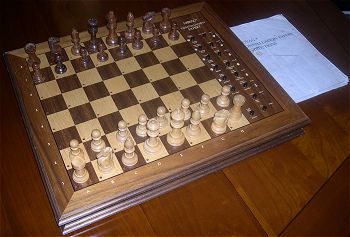 Constellation Expert (Novag)
Constellation Expert (Novag)The Novag Constellation Expert is a variant of the Super Constellation in a wooden auto-response board . There was not any display yet and some functions like the position evaluation were available only with the printer.
Here is a test game.



A Novag Super Expert 6 (6MHz). It is still in its box with all the original parts. But the chessboard colour was faded by the sun.
Here is a test game.
Super Expert B (Novag)
 The Novag Super Expert series was produced during 4 years: Super Expert in 1987,
Super Expert B in 1988,
Super Expert C in 1989 and a new generation Super Expert C in 1990.
The Novag Super Expert B adds many imorvements to the Super Expert. It wins more than 100 ELO
to reach a score of around 2000 ELO - very similar to the Super Expert C.
The Novag Super Expert series was produced during 4 years: Super Expert in 1987,
Super Expert B in 1988,
Super Expert C in 1989 and a new generation Super Expert C in 1990.
The Novag Super Expert B adds many imorvements to the Super Expert. It wins more than 100 ELO
to reach a score of around 2000 ELO - very similar to the Super Expert C.
Here is a test game.
Super Expert C (Novag)
 The Novag Super Expert C (1989) is the chef d'oeuvre of David Kittinger. It's one of the best and one of the last software
published on a 8 bits processor (6502 6MHz, around 2000 ELO).
The Novag Super Expert C (1989) is the chef d'oeuvre of David Kittinger. It's one of the best and one of the last software
published on a 8 bits processor (6502 6MHz, around 2000 ELO). This game is like new: It was allmost never used and was kept well protected.
It has a very nice game style, an unusal and very complete opening library and it is strong in finales with its "Selective Search" algorithm. Here is a test game.
Diablo 68000 (Novag)
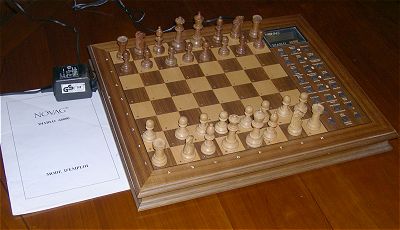 The Diablo is from 1991. It's a Novag Super Expert variant ported on a 16 bits 68000 processor.
It's the srongest chess software from this serie - around 2100 ELO. But in 1991, this kind of expensive game was
not easy to sell (around 1000 euros in France) - especially on a market dominated by Mephisto.
It also existed as plastic box under the name Scorpio.
The Diablo is from 1991. It's a Novag Super Expert variant ported on a 16 bits 68000 processor.
It's the srongest chess software from this serie - around 2100 ELO. But in 1991, this kind of expensive game was
not easy to sell (around 1000 euros in France) - especially on a market dominated by Mephisto.
It also existed as plastic box under the name Scorpio.It has a very nice and agressive game style. But it does not react properly to the pawn h attack during this test game.
 Novag Printer
Novag PrinterThe Novag Printer works with the 3 wooden electronic chess above. It prints positions, list of moves, evaluations etc.
The 24 Volts power supply is plugged on the chessboard, near the other power supply.
Mondial II (Mephisto)
 In Décember 1985, Frans Morsch appeared for the first time in an article of
Jeux et Stratégie titled:
Mephisto attacks on all the fronts: "From the Dutch Frans Morsch (
newcomer in the small closed world of programmers who sell their work): Mona installed inside the
Mephisto Mondial 16Kb of ROM, 6502 processor, it has more or less the same strength as the
Sensory 9 and the Constellation. As it should cost only 1900F, here is a small chess computer
with an excellent value for the price. Because the Mephisto Mondial has many qualities: sensory board
with 16 leds and 16 keys, 8 game levels, 7 problem levels (very efficient and able to give different solutions
when there are some), takeback until... 104 moves, display of the analyse depth,
Work on battery or plugged. There are less defaults: Clear weakness in finales and difficulty
to visualise moves due to the coordinate system."
In Décember 1985, Frans Morsch appeared for the first time in an article of
Jeux et Stratégie titled:
Mephisto attacks on all the fronts: "From the Dutch Frans Morsch (
newcomer in the small closed world of programmers who sell their work): Mona installed inside the
Mephisto Mondial 16Kb of ROM, 6502 processor, it has more or less the same strength as the
Sensory 9 and the Constellation. As it should cost only 1900F, here is a small chess computer
with an excellent value for the price. Because the Mephisto Mondial has many qualities: sensory board
with 16 leds and 16 keys, 8 game levels, 7 problem levels (very efficient and able to give different solutions
when there are some), takeback until... 104 moves, display of the analyse depth,
Work on battery or plugged. There are less defaults: Clear weakness in finales and difficulty
to visualise moves due to the coordinate system."The Mondial II is an enhanced release with 32Kb ROM. See a test game.
Europa (Mephisto)

The Mephisto Europa is a variant of the Mephisto Mondial II published end 1987. It's a game for learning and it includes the different functionalities of the Mephisto Mondial. But it includes less memory (16K instead of 32).
The game is rated around 1700 ELO but an attentive good player should have no difficulty to beat it. Here is my test game. It's a strategical demonstration against such mid level software.
Marco Polo (Mephisto)

The Mephisto Marco Polo is a travel game variant of the Mephisto Europa published end 1987.
Here is a test game.
Europa A - Schachschule (Mephisto)

The Mephisto Europa A Schachschule is a new packaging in 1990 of the Mephisto Europa. It includes a black chessboard, transport briefcase, Schachschule (chess school) on the box, and a booklet to learn chess (here in German and French).
Here is a test game.
 Europa A (Mephisto)
Europa A (Mephisto)Here is a Mephisto Europa A first release, without briefcase.
It is the same game as the Schachschule. Only the package is different.
The instruction manual is in 4 languages: German, English, French and Spanish.
This game was bought in Rouen (France, Normandy) the christmas day of 1990.
 Manhattan (Mephisto)
Manhattan (Mephisto)The Mephisto Manhattan is from 1993. It succeded to the Mephisto Europa. It looks very similar but the exercise book is missing. So the "book button" is removed. The user guide is now in 6 languages with the add-on of Italian and Dutch.
It's an intersting software because it has a good level for average players and also dedicated levels for beginners. But the design is not nice and it is a bit small. Here is a test game.
Modena (Mephisto)

This Mephisto Modena was published in 1991 (see the logo "worldchampion 1991" on the box). It's a weak hardware: a 6502 at 4 MHz but with 32Kb of memory for a strong optimized software (1900 ELO). The gamebox design was later reused for very good software in a cheap package : the Milano, Milano Pro, Atlanta, Berlin and Berlin pro.
Here is a long test game.
Chess Champion 2150L (GO, InterTAN)
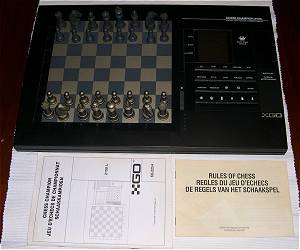 The Chess Champion 2150L was published in 1992 and was similar to the Saitek Prisma from 1990 (and to the
program of the Saitek Kasparov Blitz). It's in fact a Tandy model exported in UK, Belgium, Nederland and France with a "GO" logo.
It succeeded to the Chess Champion 2150 (Saitek Simultano, 1988). The visual difference
is very small but the content is really different: new processor risc H8-10MHz faster than the previous 65c02 5MHz.
In the Saitek catalogue, there was: "a new 32K percuting programme to solve rapidly problems".
In fact, Julio Kaplan left Saitek in 1990 and the 2150L contains a new generation software. It was probably developped by
Frans Morsch (but it's not sure).
It's a 32K program of good level (around 1700 ELO), with an opening library of 6000 half moves.
The LCD chess board, above the keyboard, shows the current position and the one analyzed by the computer.
It was sold around 150$.
Here is a test game that was not easy.
The Chess Champion 2150L was published in 1992 and was similar to the Saitek Prisma from 1990 (and to the
program of the Saitek Kasparov Blitz). It's in fact a Tandy model exported in UK, Belgium, Nederland and France with a "GO" logo.
It succeeded to the Chess Champion 2150 (Saitek Simultano, 1988). The visual difference
is very small but the content is really different: new processor risc H8-10MHz faster than the previous 65c02 5MHz.
In the Saitek catalogue, there was: "a new 32K percuting programme to solve rapidly problems".
In fact, Julio Kaplan left Saitek in 1990 and the 2150L contains a new generation software. It was probably developped by
Frans Morsch (but it's not sure).
It's a 32K program of good level (around 1700 ELO), with an opening library of 6000 half moves.
The LCD chess board, above the keyboard, shows the current position and the one analyzed by the computer.
It was sold around 150$.
Here is a test game that was not easy.Saitek Kasparov Blitz
 The Saitek Kasparov Blitz has an unusual design. There is no keyboard and the different options are
selected using 2 small wheels on the game side. It's not necessary to press the squares, the pieces are
automatically detected. But it's not with magnets: the system is using small metallic rings under each pieces.
The Saitek Kasparov Blitz has an unusual design. There is no keyboard and the different options are
selected using 2 small wheels on the game side. It's not necessary to press the squares, the pieces are
automatically detected. But it's not with magnets: the system is using small metallic rings under each pieces.The game is similar to the Chess Champion 2150L but with a bigger opening library of 17000 half moves. Here is a test game.
GK2000 (Saitek)

The Saitek GK2000, published in 1992 and evaluated 1900 ELO i still today a good program for a club player. It's a variant of the Fritz program, with an algorithm called "selectable search strategy" and a RISC processor at 10 MHz. Its game style has some similarities with the Tandy 2150L, see this test game. This program will be followed by several variants and enhancements, including the GK2100 on a processor 2 time faster.
Master 2200X (Radioshack)

The Master 2200x is from 1996 but it is clearly a GK2000 clone.
As indicated on the device, there are several options to support variants in the game style: 2 algorithms "Selective Search" and "Brute Force", one "easy mode" and also 4 options on the opening libraries: passive, active, complete and tournament.
Here is a test game. I had difficulties to play my usual opening. Most of the time, it answered c7c5 after my d2d4.
 Virtuoso (Saitek)
Virtuoso (Saitek)This Virtuoso is from 1992. The game is a bit small (around 30x30cm), the pieces and the boardgame frame are in wood, The boardgame middle is in plastic with wood colours (so you can push on each square to indicate the moves). This design is similar to the Saitek Capella (also called Schach Trainer) that contained a 16K / 10 MHz / 1800 ELO software. This Virtuoso is a bit faster: 16MHz, with an opening library of 2000 half moves and an estimated level of 1900 ELO.
Here is a test game.
 Capella (Saitek)
Capella (Saitek)The Capella is from 1996. It succed to the Virtuoso With a slower processor (10MHz instead of 16Mhz). I bought this game new, the wooden pieces are still sealed.
Here is a test game.
Kasparov Turbo Advanced Trainer (Saitek)

The Kasparov Turbo Advanced Trainer (1992) is a Virtuoso variant in the Team mate packaging. It's a very interesting software. It will later evoluate to become the MM VI/Centurion (1980 ELO), and the Mephisto Senator/Magellan (2080/2180 ELO).
Here is a test game.
Schach-Trainer (Saitek)
 This Saitek Kasparov Schach-Trainer was included in a special edition for the world championship of 1995.
In 1994, Saitek bought Hegener & Glaser (who owned Mephisto), so the game was distributed in a box with both names
Saitek and H&G but without any reference to Mephisto. The game had no English name. The user manual was in German, French and
Dutch. In 2003, Saitek distributed another Mephisto Chess Trainer but it was a different game.
This Saitek Kasparov Schach-Trainer was included in a special edition for the world championship of 1995.
In 1994, Saitek bought Hegener & Glaser (who owned Mephisto), so the game was distributed in a box with both names
Saitek and H&G but without any reference to Mephisto. The game had no English name. The user manual was in German, French and
Dutch. In 2003, Saitek distributed another Mephisto Chess Trainer but it was a different game.This game is a variant of the Virtuoso/Turbo Advanced Trainer with a bigger opening library.
You can compare this test game with the Virtuoso's one. It's clearly the same software.
 GK2100 (Saitek)
GK2100 (Saitek)The Saitek GK2100 is an improved GK2000 from 1993. It's a very good software - around 2000 ELO.
Saitek is still selling this game - but with a different design: the Saitek Centurion and today Saitek Chess Challenger.
Here is a test game.
Mephisto Module MM IV + HG 440
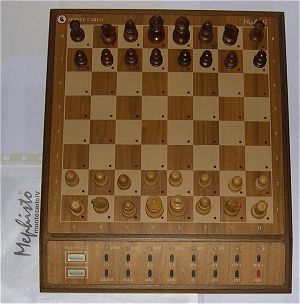 Mephisto Monte Carlo IV
Mephisto Monte Carlo IVFor H&G, Ed Schröder firest developped on the Exclusive chess board the MM-IV in 1987. The MM-IV was also distributed as a lower price under the name of Monte-Carlo: an auto-response wooden board. A game with the Monte Carlo

The HG440 module is an option that enriched the opening library. The MM-IV, Polgar, MM-V serie from Ed Schröder had a great success due to its price and quality. Here is a test game with the Monte Carlo.
 Mephisto Exclusive MM IV
Mephisto Exclusive MM IVThe MM-IV was mainly sold inside this very nice wooden Mephisto Exclusive chessboard. But it was also available at a smaller price in the Mephisto Modular chessboard with plastic pieces.
Here is a test game with the MM-IV.
Mephisto Polgar (1989)

10 years after my Chess Traveler, this Mephisto Polgar was the second chess computer I bought.
H&G had the good marketing idea to use the name Polgar on an average-good program. Still today, this machine is a collector, especially with the original Mephisto briefcase.
Without being a champion, it's a good programm but it missed speed with a 6502 / 5 MHz. It is estimated around 1850 ELO (and 1950 for the 10 MHz release).
Here is one of my most beautiful games.
Mephisto Milano

The Mephisto Milano is a "low cost" variant of the Mephisto Polgar. The software has only minor differences: I replayed the Polgar game and during 40 moves, only 4 were different.
The Mephisto Milano is very different from the Mephisto Milano Pro. The Milano Pro is identical to the Mephisto Master Chess. It includes a variant of the Mephisto Senator.
Here is a test game.
Mephisto Exclusive MM V

The MM-V was published in 1990. It was the last software from the 6502 5 MHz serie. It succeeded to the MM-IV and is different from the Polgar, in the user interface aspect and also probably in the game style.
It has an ELO level of 2000 and that's a performance on a first generation processor.
Here is a test game with the MM-V
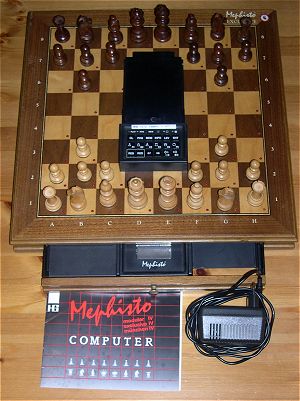

In 1988, one year after the arrival of the MM-IV, a German company realized a Turbo Kit to accelerate the MM-IV with a 16MHz processor instead of 5MHz. The benefit was 150 ELO (from 1984 to 2121). The MM-V and the MM-IV had some compatible hardware and here you have an unofficial module that includes the MM-IV turbo accelerated to 18MHz, its opening library HG-440 and also a MM-V / HG-550 at 18MHz. A small switch behind the module is used to change from one software to the other.
Both software won tactical force keeping their game style. The MM-IV and the MM-V are quite different in game style. I replayed the MM-IV test game on the turbo and the difference was small: 2 switched answers (move 7 and 8) and only one different move in the end of the opening (knight in c6 instead of d7). The MM-V turbo played differently at the 3rd move so I played a new test game. It's a very high level software.
 Mephisto MM-IV MM-V Turbo 10 MHz
Mephisto MM-IV MM-V Turbo 10 MHzHere you have another unofficial MM-IV & MM-V turbo module with an embedded opening library module. This one is at 10 MHz, 2 time faster than the original module. A small switch behind the module is used to change from one software to the other.
The MM-V here accelerated at 10 MHz is one of my favourite chess software with a very human style in the middle game. Here is a test game ŕ 3mn par coup.
 Mephisto Risc II
Mephisto Risc IIThe Mephisto Polgar was already very good on a weak processor. When it was adapted to a Risc processor that was a lot more powerful, it became world champion in 1991. The module was called Risc 1MB (in fact, it has 128Kb of Rom and 1Mb of Ram). 2 releases existed: Risc and Risc II a bit stronger. This software is also known under the name Gideon. The module looks like the Polgar. The power adapter is plugged directly on the module. The hardware is fragile. Sometime, it has difficulties to switch on and it's important to use the original power adaptor.
This game was sold inside its business case with the logo Mephisto:



CXG Chess 3000
 CXG mainly produced low cost chess games. But they also designed a set of nice wooden games visible on
this photo page on flickr.
CXG mainly produced low cost chess games. But they also designed a set of nice wooden games visible on
this photo page on flickr.The CXG Chess 3000 is from 1986. It is based on a 16Kb software on a 6MHz Z80 processor. The programmer is ... Richard Lang ... and this is a software derived from the CXG Chess 2001, its first electronic chess game available on the market in 1983. It is not very strong (1570 elo) but it plays a nice game style and it is not so easy to beat when the average time is 3mn30 per move. See a test game.
Mephisto Roma II (68000)
 The Roma II (1989) is a Mephisto/Richard Lang software from the famous "world champion" serie,
published by H&G
(Hegener & Glaser). There was in fact 2 software generations: the first between
1985 ŕ 1988 (Amsterdam/Dallas/Roma) and a new software after 1988
(Almeria, Portorose, Lyon, Vancouver).
The Roma II (1989) is a Mephisto/Richard Lang software from the famous "world champion" serie,
published by H&G
(Hegener & Glaser). There was in fact 2 software generations: the first between
1985 ŕ 1988 (Amsterdam/Dallas/Roma) and a new software after 1988
(Almeria, Portorose, Lyon, Vancouver).The Roma II is a lightly downgraded Roma 68000 (10 MHz instead of 12 MHz). It was a bit weaker but was compatible with the travel game Mephisto Mobil LCD.
After the Roma, the software "world champion" was rewritten following the state of the art rules of software programming to improve the level of functionality, the game level and to ease any further enhancement. Here is a test game: It has some difficulty to see risk situations after 4 or 5 moves in advance.
 Mephisto Montreal 68000
Mephisto Montreal 68000The Mephisto Montreal 68000 is from 1993. It includes a variant of the Mephisto Roma with a better way to display game levels: alphanumeric instead of numbers.
The chessboard looks like a Mephisto Exclusive but the module is fixed. This chessboard is a bit damaged in the middle squares. Here is a test game
Mephisto Almeria 16 bits
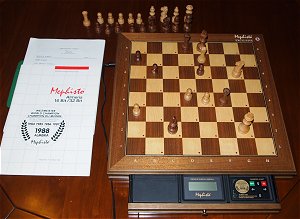 The Almeria (1988) is the first software by Richard Lang from the second "world champion" serie.
The Almeria (1988) is the first software by Richard Lang from the second "world champion" serie.Here it's the 16 bits release inside a Mephisto Exclusive board. It's a very strong player - with a very nice game style -more than 2000 ELO but its hardware is limited compared to the one of the real turnament machine used in Almeria. This turnament machine is rated more than 2250 ELO.
Here is a very interesting description of the tournament machine from the "chess computer UK" website.
This software will not change so much later. I tested it on a game played with the Vancouver 16 bits (1991).There are only very little differences. Here is this test game.
Mephisto München Portorose 68020 (32 bits)
 The Portorose (1989)is a software by Richard Lang from the second "world champion" serie.
The Portorose (1989)is a software by Richard Lang from the second "world champion" serie.It's the 32 bits release in a Mephisto München board a lot bigger than the Mephisto Exclusive.
It's a very strong software (around 2100 ELO). Here is a test game showing well its game style: some unusual openings, a powerful middle game and some small weaknesses in finales.
Mephisto Lyon 16 bits
 The Lyon (2100 ELO) succeeded to the Portorose in 1990. The 1990 world championship was
in France and this game was probably targeted for the French market, usually sold with a user manual in French and German.
But this game includes the Vancouvers manual, in English and German.
The Lyon (2100 ELO) succeeded to the Portorose in 1990. The 1990 world championship was
in France and this game was probably targeted for the French market, usually sold with a user manual in French and German.
But this game includes the Vancouvers manual, in English and German. Theorically, it's a software very similar to the Vancouver one. So I replayed the 2 games already won against the Vancouver and there are only small differences. In the first game at 2 mn per move, the game was identical until the move 29, that was a desesperate move because the Lyon was begining to lose. In the second game at 3 mn per move, the game was identical only until the move 12, in the end of the opening phase and of course, the follow up was different.
I also started to replay the game against the Mephisto Portorose 32 bits but I found also small differences: in the opening (move 3) then at the 11th move.
Mephisto Vancouver 68000 (16 bits)
 The Vancouver (1991) is the last Mephisto software from the famous "world champion" serie published by H&G (Hegener & Glaser).
H&G bankrupted and was bought by Saitek in 1994. And in 1996, another variant
became world champion and was distributed under the name London.
The Vancouver (1991) is the last Mephisto software from the famous "world champion" serie published by H&G (Hegener & Glaser).
H&G bankrupted and was bought by Saitek in 1994. And in 1996, another variant
became world champion and was distributed under the name London.The world champion serie is the result of a teamwork: a software from Richard Lang, a huge opening library developped by Ossi Weimer, tests made by strong players and of course a powerfull hardware. From the start, the world champion serie was available on a powerfull hardware at an expensive price. This Vancouver module is the lower cost 16 bit release on a 68000 12MHz, rated 2100 ELo. It was also available on a 68020 (32 bits), rated 2160 Elo and on a 68030 36 MHz, rated 2230 Elo (the one used for the world championship). The electronic board looks very clean.
It's my prefered software because it has a very nice playing style and because it's a very good tool to learn. I found an opening with a very small white advantage, so I was able to beat him in these 2 test games: Game 1 (2mn per move) and Game 2 (3mn per move). When it attacks, it takes some risks and when the opposite player is able to find the best defense, he can step by step build an advantage. Of course, it's easier when he cheats using the take back function (so easy to use).
Links:
- An interview of Richard Lang (German+English).
- A game between Peter Leko (13 years old) and the Mephisto Vancouver (1992).
- Take a look to the game 3 "Ramón Ibáńez (Valencia) vs Mephisto London 68030". Ramón Ibáńez is able to win in only 27 moves ! A very nice attack starting with one pawn at move 14 with sacrifice of one rook against a bishop just after.
- Another kind of Mephisto Vancouver for $200.
Mephisto Berlin Professional (68020)

The Mephisto Berlin Pro is in the top 20 of the best eletronic chess games in the world (2226 ELO). It's a game in the middle of the Vancouver 32 bits and the Mephisto Genius 68030: It's an improved release of the Vancouver with a faster processor (24 Mhz instead of 12) and a bigger opening library. It's a downgraded release of the Genius 68030 because the processor is a 68020.
It's a very strong software, very agressive, but I found a weakness in this test game.
Mephisto Berlin (68000)

The Mephisto Berlin is the young brother of the Berlin Pro. With a smaller processor, 2 time slower, it lost around 100 ELO but remained very strong (around 2150 ELO).
It's a very good software, with many options varrying the game style.This time I tested the option to open the collumn in front of the h rook by doubling the pawns in g. Here is this test game.
Mephisto London 68020


The best "Mephisto Exclusive" module from Richard Lang was the Genius 68030. The same software was also available as upgrade for the Vancouver/Lyon 68000 and 68020 under the name "London upgrade". Here you have a London 68020 at 12 MHz and this is a very strong software - 2200 ELO - with a very nice game style.
Here is a test game with a nice duel queen against rook + pawn.
 Mephisto Genius 99 (CD-ROM)
Mephisto Genius 99 (CD-ROM)In 1998, the name of Mephisto was used for a PC software. It was a program from Richard Lang and it was designed by a company called "Lang Software, England". In Germany, it was translated and distributed by "Millennium 2000 GmbH, München".
This CD-ROM came from Germany. the software is in English or German. It was designed for a PC 386 under Windows 3.1, 95 and 98. It still works today without problem on the most recent PC. It's a complete program, with 230000 master games, hashtables etc.
It was designed to be connected to the auto-response boards Mephisto-PC (or TASC Smartboard)
Gambit (Fidelity)

Ron Nelson realized the first Chess Challengers. When the game level raised, around 1982, he stopped to develop chess software. But there was probably stocks of the Chess Challenger 8 "The classic" because in the end of the 80s, this software was repackaged in lower cost games.
The Gambit is derived from the Chess Challenger 8 - similar to "the classic" - but it was published in 1987. It's still a weak software, as you can see in this test game.
Designer 1500 (Fidelity)

The Designer 1500 is in a nice package, designed by Franco Rocco. To my mind, it's the most beautiful of the designer serie.
In Jeux et Stratégie n°54 (1988), the comment was: "Nice design but with the Chess Challenger 8 program. We do not understand why Fidelity did not chose a better program for such a low price computer chess."
It has the weak software already included in the Fidelity Gambit, see this test game.
Excalibur Mirage

Ron Nelson is first of all famouse because he created the first Chess Challengers. But he is also today VP Engineering for Excalibur Electronics. He reused the Fidelity Phantom patent on this Excalibur Mirage from 1997. It is the last chess robot realised until today. it moves itself its pieces. It is well known to be fragile and to have some minor bugs. Mine works well except the LCD screen that is very uncomplete:

It contains a good software, rated around 1800 ELO, see this test game . Here are two links in German about chess robots: Die Schachroboter and Alle Schachroboter.
 King Arthur (Excalibur)
King Arthur (Excalibur)Excalibur computer chess are mainly distributed in the USA. But this one is European with an English package but a user manual in English, French and German. The French translation is understandable but a bit funny: setting up special positions is translated by something like "reordering special constellation". This game is rated 1750 elo. It's an interesting player because it has his own style, very different from the other machines and I suffered a lot during this test game. To my mind, 1750 Elo seems to be underestimated. It's perhaps linked to weaknesses in finales or to a specific strength on my specific d2d4 opening. Also, This game is nice for very young players because they can easily beat it at level 1.
A link: Product review in www.thechesspiece.com